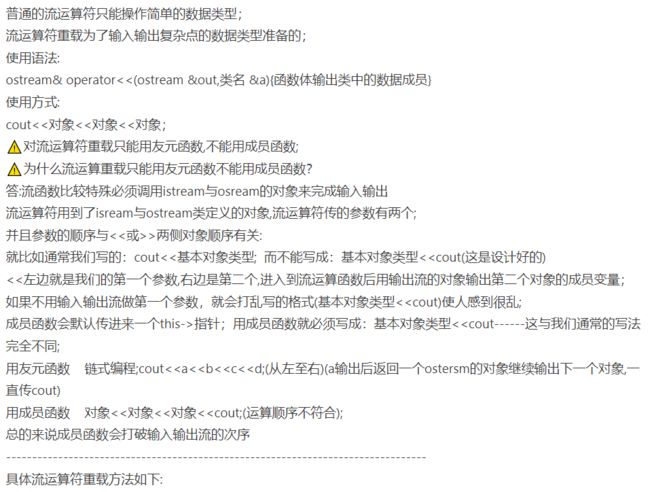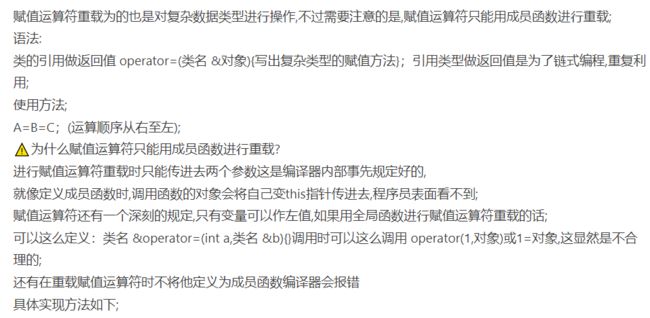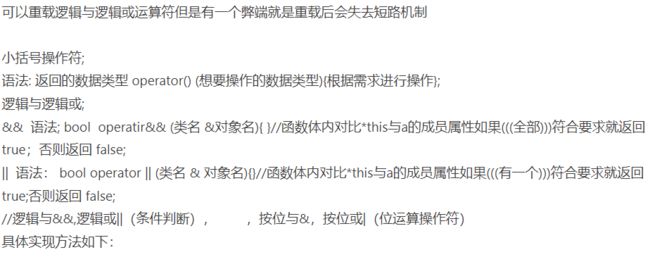一文详解C++运算符重载【自己动手封装一个xxx.h库】
文章目录
- 前言
- 一、对运算符重载的初步认知
-
- 1.成员函数运算符重载
- 2.友元函数运算符重载
- 二、二元运算符重载
-
- 代码实现
- 三、一元运算符重载
-
- 前置加加前置减减:
- 后置加加减减:(比前置加加减减多一部操作)
- 代码实现
- 四、流运算符与友元函数的密不可分
-
- 代码实现
- 五、赋值运算符与成员函数的密不可分
-
- 代码实现
- 六、索引运算符与等号不等号运算符
-
- 代码实现
- 七、小括号与逻辑运算符
-
- 代码实现
- 八、不等号运算符重载
-
- 代码实现
- 九、综合小练习与类的分文件管理
-
- ⚠️类定义的头文件 mystring.h
- ⚠️类实现的文件 mystring.cpp
- ⚠️使用类的文件 testmain.cpp
- 总结
前言
默认的运算符只能进行简单的运算操作;操作符重载是为了应对复杂数据类型的运算;也是为了后期的泛型编程进行前置准备。操作符重载表面上看来是对复杂类型进行操作,实际上是疏通了复杂类型之间计算的方式,将他内部各个击破,并把最终的答案呈现到我们面前;不能用友元函数重载的操作符有:= () [] ->、流运算符只能由友元函数进行重载
一、对运算符重载的初步认知
早期我们只知道1+1=2,“Hell”+“o World”=“Hello World”,那么自己实现一个类如果创建两个对象能不能进行相加呢?没有实现运算符重载的时候答案是不能,实现了运算符重载就可以轻松达到我们的目的。
运算符重载一般有两种方式,运算函数为成员函数或者友元函数【友元函数本专栏前面提到过】
运算符函数外表长这样
该对象类型 operator-(该对象引用类型 b);
上面那个是减运算符的重载。
1.成员函数运算符重载
顾名思义就是将operator函数写进类的成员函数,前面提到过友元函数不一定安全,
所以能够使用成员函数进行运算符重载就不使用友元函数。
test operator-(test& b){
test c(this->a - b.a, this->b - b.b);
return c;
}
2.友元函数运算符重载
流运算符只能使用友元函数进行重载。
//声明
friend test operator+(test& a, test& b);
//实现
test operator+(test& a, test& b) {
test c(a.a + b.a, a.b + b.b);
return c;
}
二、二元运算符重载
通俗的来讲二元运算符重载是为了解决两个数据类型复杂的变量之间的运算操作;
操作符关键字使用语法:
类型 operater(要重载的运算符)(参数列表){实现方法};
可以分为:1.全局函数操作符重载 2.成员函数操作符重载;
具体实现方法如下:
(友元函数可以对类的成员属性直接操作,有时结合使用更方便)
代码实现
代码如下:
#include三、一元运算符重载
一元运算符重载包括:前置加加减减,后置加加减减
前置加加前置减减:
1.友元函数
2.成员函数
直接对传进来的对象操作,操作后直接返回(如果用引用将对象传递进来可以不用返回
,因为引用已经对原来的对象进行了操作)操作完后直接使用结果
后置加加减减:(比前置加加减减多一部操作)
1.友元函数
2.成员函数
对传进来的对象AAAA进行备份,因为本次操作还使用对象改变前的变量,当操作完后将备份
的对象返回出去;其实此时的对象AAAA已经改变了,但是只要我们操作的好 表面看来就符
合了后置加加的语法;
⚠️注意:返回类型不是判断函数重载的标准,而一元运算符重载常常会有很多函数名相同函数参数相同的重载函数
此时可以用占位符化解它们之间的矛盾;使他们构成重载;
代码实现
代码如下:
#include四、流运算符与友元函数的密不可分
代码实现
代码如下:
#include五、赋值运算符与成员函数的密不可分
代码实现
代码如下:
#include六、索引运算符与等号不等号运算符
代码实现
代码如下:
//流运算符,赋值运算符,下标运算符,等号不等号运算符的重载
#include
return (this->p)[i];//this->p代表this对象里面的一个成员变量,在这里是一个字符数组
//并且在这里return 时调用了默认的[]操作函数
}
int main_HH() {
char aa[] = "I am big shuai" ;
char bb[] = "I am zhu zhi chong";
char dd[] = "Shuai bi";
MyClass a1(1, 2), a2(3, 4);
MyClass b1(aa), b2(bb),b3(dd);
cout << a1 << a2;
b1 = b2=b3;//经过这里赋值函数之后,b1,b2,b3的len均相等;
// b1.print();
// b1.printp(b1);
cout << b1[4] << endl;//成功将对象里面的字符拿出来,并调用了重载的[]函数
if (b1 == b2) {//b1b2相等调用了这里
cout << "等号函数,重载成功over" << endl;
}
if (b1 != a1) {//b1,.a1的len不相等所以这里也进行了输出
cout << "这里是不等号,over" << endl;
}
return 0;
}
七、小括号与逻辑运算符
代码实现
代码如下:
#include八、不等号运算符重载
可以根据需求对大于小于运算符进行重载;
这样可以很直观的对比出来两个对象的某一特征,找出哪个更胜一筹;
成员函数语法 bool operator(类名 &对象名){函数体进行对象的某一特征进行比较};
友元函数语法 bool operator(类名 &对象名,类名 &对象名){函数体同上};
代码实现
代码如下:
//大于小于运算符重载
//判断条件运算符返回值一般就0,1两种;
//并且符合返回1,也就是真,因为调用的场景一般就是if语句:
//if语句中只有判断条件为真才会执行代码块里面的语句;
//如果if语句为真那么下面附属的else 语句将不再执行;
#define _CRT_SECURE_NO_WARNINGS
#include直接返回与
}//小于操作符的返回值也就是 !(*this
bool MyClass1::operator>=(MyClass1& a) {
return !(*this <= a);
}
int main_DX() {
char aa[] = "aaaaa";
char dd[] = "bb2222";
MyClass1 a1(aa), a2(dd);
if (a1 > a2) {
cout << "这里是大于号" << endl;
}
if (a1 < a2) {
cout << "这里是小于号" << endl;
}
if (a1 <= a2) {
cout << "这里是小于等于号" << endl;
}
if ( a2>=a1 ) {
cout << "这里是大于等于号" << endl;
}
return 0;
}
九、综合小练习与类的分文件管理
对含有字符串的对象进行赋值,下标不等号等号以及输入输出流运算符进行重载;
⚠️类定义的头文件 mystring.h
只有类的属性与方法的声明
#pragma once
#include⚠️类实现的文件 mystring.cpp
对前面类的声明中的方法进行了实现。
#define _CRT_SECURE_NO_WARNINGS
#include "mystring.h"
#include⚠️使用类的文件 testmain.cpp
测试分文件后实现类的效果【引入自己封装好的.h文件】
#include总结
这些运算符重载是博主在大一刚入门c++的时候记录的学习笔记,由于重载的运算符较多,所以大家可以对比学习,找出相同点与不同点。



